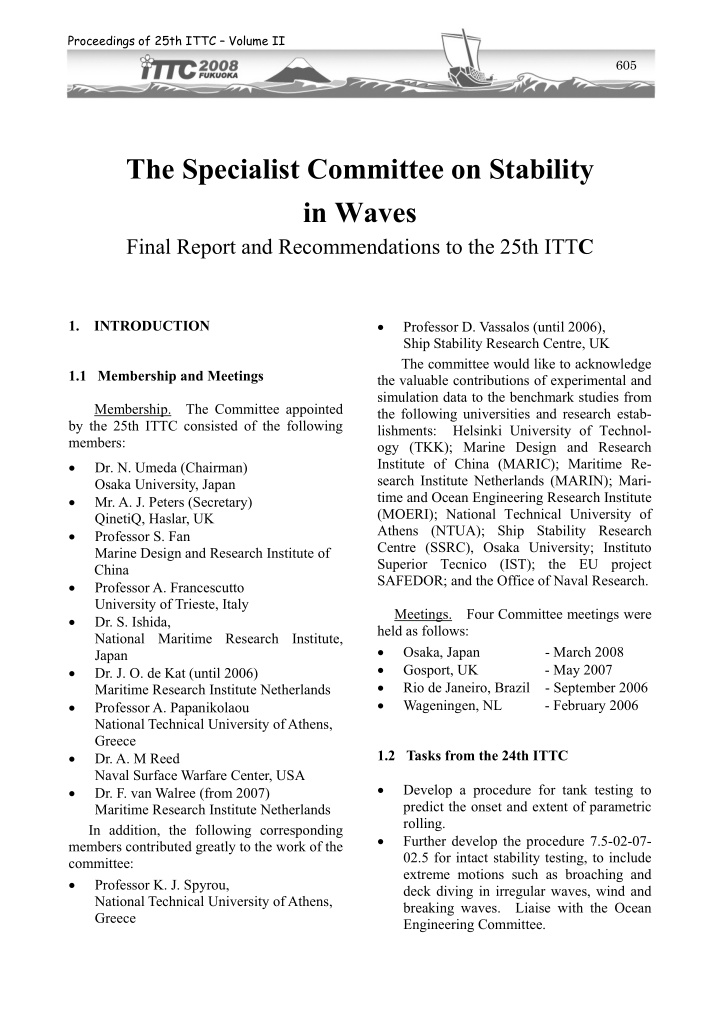



Proceedings of 25th ITTC – Volume II 605 The Specialist Committee on Stability in Waves Final Report and Recommendations to the 25th ITT C • 1. INTRODUCTION Professor D. Vassalos (until 2006), Ship Stability Research Centre, UK The committee would like to acknowledge 1.1 Membership and Meetings the valuable contributions of experimental and simulation data to the benchmark studies from Membership. The Committee appointed the following universities and research estab- by the 25th ITTC consisted of the following lishments: Helsinki University of Technol- members: ogy (TKK); Marine Design and Research Institute of China (MARIC); Maritime Re- • Dr. N. Umeda (Chairman) search Institute Netherlands (MARIN); Mari- Osaka University, Japan time and Ocean Engineering Research Institute • Mr. A. J. Peters (Secretary) (MOERI); National Technical University of QinetiQ, Haslar, UK Athens (NTUA); Ship Stability Research • Professor S. Fan Centre (SSRC), Osaka University; Instituto Marine Design and Research Institute of Superior Tecnico (IST); the EU project China SAFEDOR; and the Office of Naval Research. • Professor A. Francescutto University of Trieste, Italy Meetings. Four Committee meetings were • Dr. S. Ishida, held as follows: National Maritime Research Institute, • Osaka, Japan - March 2008 Japan • Gosport, UK - May 2007 • Dr. J. O. de Kat (until 2006) • Rio de Janeiro, Brazil - September 2006 Maritime Research Institute Netherlands • • Wageningen, NL - February 2006 Professor A. Papanikolaou National Technical University of Athens, Greece 1.2 Tasks from the 24th ITTC • Dr. A. M Reed Naval Surface Warfare Center, USA • Develop a procedure for tank testing to • Dr. F. van Walree (from 2007) predict the onset and extent of parametric Maritime Research Institute Netherlands rolling. In addition, the following corresponding • Further develop the procedure 7.5-02-07- members contributed greatly to the work of the 02.5 for intact stability testing, to include committee: extreme motions such as broaching and • Professor K. J. Spyrou, deck diving in irregular waves, wind and National Technical University of Athens, breaking waves. Liaise with the Ocean Greece Engineering Committee.
Specialist Committee on Stability in Waves 606 • capsize scenarios, and have been used to Identify experimental techniques and data for validation of time-domain capsize identify different modes of extreme motions and capsizing of intact ships. To perform these codes, emphasising the selection of the experiments successfully, the ship model important parameters that influence the should be self-propelled and fitted with an capsizing behaviour of intact and auto-pilot to eliminate any external influences damaged ships. Liaise with the Ocean Engineering and Seakeeping committees. to the model’s response to the waves. Generally, the ship motions should be measured by a • Assess the state of the art for: fibre-optic gyroscope, a gyro accelerometer or o Practical application of numerical an optical tracking sensor. The measured methods for the prediction of capsizing signals should be stored by an onboard and experiments for assessment of computer, or transmitted to shore by radio link safety/risk against capsize. or umbilical cable. o Make recommendations as to what Roll decay tests and inclining experiments scientific progress is required to move should be performed to assess the roll damping stability regulations from those based and the transverse stability characteristics of on hydrostatic calculations to those the model. based on dynamic predictions, either Many free-running experiments on using capsize codes or physical model parametric rolling in head and bow seas have experiments. been conducted during the last three years and • Establish the importance of the following are reviewed in the following section. issues in predicting the dynamic Matsuda, et al. (2006) conducted free behaviour of damaged vessels, including running model experiments for a purse-seiner sinking and capsizing, coupling between vessel at several Froude numbers. The model floodwater dynamics and ship dynamics, capsized due to bow-diving in the severe influence of flow coefficients for openings following seas at intermediate speeds. The and flooding of complex spaces (multiple model also experienced stable surf-riding at compartments, stair wells, failing higher speeds and broaching at lower speeds. watertight doors, etc). Marón, et al. (2006) and Perez-Rojas, et al. • Review numerical methods for assessing (2007) investigated the accidents of small the length of time to sink or capsize for fishing vessels through free running model damaged passenger ships and associated experiments in beam, following and quartering validation techniques. seas. This allowed the identification of the • Continue to review developments (rele- modes of loss and the appropriateness of the vant to ITTC) in stability safety assess- stability regulations for this type of vessel. ment, with special attention on perform- ance and risk-based approach and relevant developments at IMO. Guided Model Experiments. Captive and semi-captive model experiments can give repeatable and certifiable experimental results 2. PREDICTION OF EXTREME MO- to verify the capability of numerical models, or TIONS AND CAPSIZING OF INTACT to obtain information on forces, moments and SHIPS motions. If the model is towed, the towing point should be carefully selected to avoid undesirable effects on the significant motions. 2.1 Experimental Technique for Capsizing Ikeda, et al. (2005) carried out guided in Wind and Waves model experiments for a large passenger ship to investigate the effects of wave height and Free Running Experiments. Free running bilge keel arrangements on the occurrence of model experiments can be used to investigate parametric roll in beam seas. The model was
Recommend
More recommend